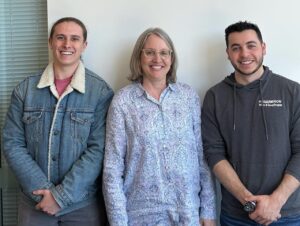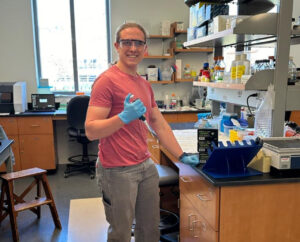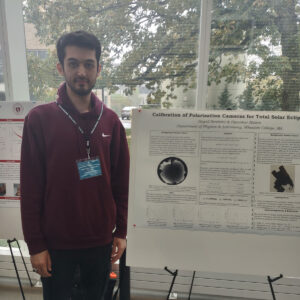WISE supports research collaborations between New Majority students and Wheaton STEM faculty. These fellowships provide an opportunity for students to explore original research questions, use state-of-the-art techniques, and learn data analysis skills in faculty laboratories.
Below are a sample of 2023-24 projects and research summaries.
Expression of MMP-13 Protein in Wild Type and Long-Finned Zebrafish
Faculty: Jennifer Lanni, Associate Professor in Biology
Student: Richie Hughes, Class of 2024
Richie studied the expression of a specific protein (MMP-13) in wild-type and long-finned zebrafish at several stages of development. His work is relevant to Dr. Lanni’s on-going investigation of how the innate immune system may play a key role in regulation of fin size. The MMP-13 is secreted by neutrophils, a cell type in the innate immune system that responds to injury by causing an inflammatory response. Richie studied the presence of MMP-13 in embryos, adolescents, and adult fish using BCA assays, SDS-PAGE, and Western blots. These results will help show whether long-finned fish may be in a state of chronic inflammation/healing, which can be linked to their perpetual fin growth.

A Study of the Sky Polarization Due to the Earth’s Atmosphere During a Total Solar Eclipse
Faculty: Dipankar Maitra, Associate Professor of Physics/Astronomy
Student: Sayed Abdul Ahad Ibrahimi, Class of 2025
Sayed’s project involved using a fisheye lens attached to a polarization-sensitive camera to obtain images of the entire sky during the total solar eclipse (TSE) on April 8, 2024. It is speculated that polarized light from the solar corona significantly alters the overall polarization pattern of the entire sky during a TSE, as observed from the Earth’s surface. There has been only one previous refereed publication hinting at intriguing changes in overall sky polarization properties during a TSE, based on data taken during a TSE in 2017. More high-quality data is needed to understand this phenomenon better.
Greenhouse Gas Dynamics in Small Pools
Faculty: Matthew Evans, Professor of Chemistry and Geology
Student: Julie Maxwell, Class of 2026
The main focus of this project is to examine greenhouse gas (carbon dioxide and methane) emissions from small pools ranging from vernal pools to man-made impoundments. The work involves multiple types of field sampling of pools, laboratory analysis of those samples and working with the data to determine fluxes. The main goals are:
- Characterize the pools near campus and use samples to determine an overall GHG flux from the region
- Determine if there are differences in GHG flux/character in pools that have been impacted by road salt (as a measure of human impact)
- Determine if there are observable differences in GHG dynamics in pools as they go through wet/dry cycles
Definition of Moving Plates Near Belas Linea Europa
Faculty: Geoffrey Collins, Professor of Geology
Student: Clayton Walker, Class of 2027
This project investigates plate tectonic-like activity on the surface of Jupiter’s moon, Europa, in a promising area near Belus Linea. Clay has been very enthusiastic about this project, and this is the perfect opportunity for him to take a deeper dive, develop organizational and leadership skills, and gain experience in the messiness of cutting-edge research. Clay’s responsibilities will include translating the current hand-drawn map into a database of potential plate boundaries and maintaining a shared online map document of what has been searched. He will work with Dr. Collins to define potential plates based on search results and digitize the boundaries in GPlates software to begin the process of detailed plate motion studies.


